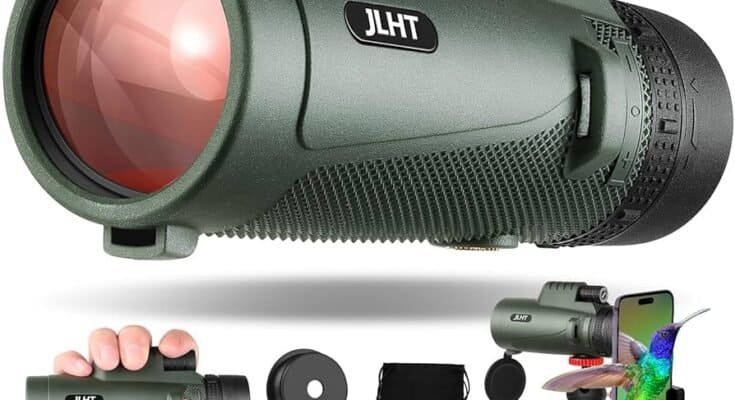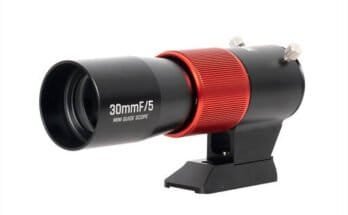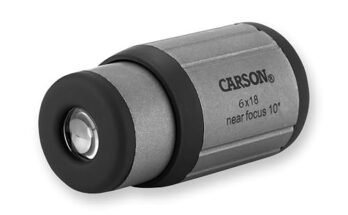I’ve spent many dawns glassing ridgelines and timber edges, and I know the value of good optics. So let’s answer the big question right away: yes, you can use a monocular for hunting, and for many hunters, it’s a smart, light, and fast tool. In the right hands, a monocular helps you find sign, scan cover, and spot game without the bulk of binoculars. In this guide, I’ll share how, when, and why to use one, plus the pitfalls to avoid. If you’ve wondered, Can you use a monocular for hunting?, this is your complete, field-tested playbook.

What Is A Monocular And How It Helps Hunters
A monocular is a small, single-barrel optic. Think of it as half of a binocular. It offers magnification to help you see details far away. For hunters, that means reading terrain, checking movement, and confirming what you saw with the naked eye.
Most hunting monoculars range from 6x to 12x magnification. They are small, light, and often pocket-sized. That makes them easy to carry, fast to deploy, and ideal for quick scans when you do not want the weight of full-size binoculars.
From my experience, a compact 8x or 10x monocular can be perfect in thick woods and broken country. You can glass a hillside, then tuck it away and move. When you need both hands on your rifle or bow, less weight matters. A monocular keeps your kit simple.

Pros And Cons Of Using A Monocular For Hunting
Using a monocular is a trade-off. It shines in some roles and falls short in others. Here is a clear look based on field use and optics best practices.
Pros
- Light and small. Easier to pack and carry all day.
- Fast to use. One hand, quick peek, then back to the hunt.
- Budget-friendly. Quality options often cost less than binoculars.
- Great for dense cover. You do not need wide views in tight woods.
- Versatile. Doubles for reading tracks, checking trail markers, or scanning the next ridge.
Cons
- Eye strain. One eye does all the work, which can tire you faster during long glassing sessions.
- Narrower field of view. You see less at once compared to binoculars of the same power.
- Less stable at high power. 12x and up can shake unless braced or tripod-mounted.
- Limited low-light performance on small objectives. Dawn and dusk performance depends on glass quality and lens size.
- Not a rangefinder. You still need a rangefinder to measure distance with precision.

Monocular vs. Binoculars vs. Spotting Scope vs. Rangefinder
Each optic has a job. Pick the one that fits your hunt.
- Monocular. Best for fast, light, short-to-mid scans. Great in timber, still-hunting, and mobile setups.
- Binoculars. Best for sustained glassing. Wider view, less eye strain, better for open country and long sits.
- Spotting scope. Best for long-range detail. Ideal for judging antlers or counting points at distance. Needs a tripod.
- Laser rangefinder. Best for distance. Not for scanning, but essential for ethical shots.
Real talk from the field: I run a monocular on quick still-hunts in thick stands. For open country mule deer, I grab binoculars on a tripod and a spotter. In bow season, I pair a small monocular with a rangefinder. It keeps my chest rig light and my workflow simple.

How To Choose A Hunting Monocular
Focus on clarity, comfort, and durability. Specs matter, but field performance matters more.
Key features
- Magnification. 8x to 10x is the sweet spot for stability and field of view.
- Objective lens. 25 to 42 mm balances brightness and size. Larger lenses gather more light but add bulk.
- Glass and coatings. Look for fully multi-coated lenses and quality prisms for sharp, bright images.
- Eye relief. If you wear glasses, aim for 15 mm or more.
- Field of view. Wider views help you find animals faster.
- Focus system. Smooth, precise focus is key with gloves on.
- Waterproof and fogproof. Nitrogen or argon purged with O-ring seals for rough weather.
- Grip and armor. Non-slip texture and rubber armor resist drops and rain.
- Weight and size. Pocketable is good if you hike far.
- Warranty. A strong warranty shows brand confidence.
Practical tip: If possible, test side by side at dusk. Low light reveals real quality. High-contrast edges and minimal glare help you find animals that blend into shadows.

Field Techniques: Using A Monocular The Right Way
Using a monocular well is about steady hands, smart scanning, and good light.
Steady the view
- Brace against a tree, trekking pole, or your pack.
- Pin your elbow to your ribs to reduce shake.
- Use a short lanyard and pull it taut for tension.
Scan with purpose
- Break the scene into grids and scan slow.
- Look for parts of animals. Ear flicks, horizontal lines, and color breaks stand out.
- Pause often. Your brain needs a second to catch movement.
Work with light
- Glass with the sun at your back when possible.
- Use a lens hood or your hat brim to cut glare.
- Clean lenses often. Dust and fog kill detail.
Silent setup
- Keep it in an easy-access pocket or chest rig.
- Practice one-hand use so you stay quiet and still.
Ethical range
- Use a rangefinder for shot distance.
- If you only have a monocular, learn landmark distances in advance and be conservative.
From the field: I learned to grid scan after missing a bedded buck 60 yards below me. With a monocular, small moves matter. Slow down. Let the view settle. You will find more.

When A Monocular Makes The Most Sense
Some hunts favor a monocular. Others demand more glass.
Best fits
- Thick timber deer or hog hunts where shots are close.
- Still-hunting and tracking where you move often.
- Turkey and small game scouting.
- Minimalist backpacking when every ounce counts.
- As a backup optic in your pocket when you loan out your binos.
Think twice
- Long glassing sessions in open country.
- Judging antlers at long range.
- Extended low-light sits where eye fatigue builds.
A practical system: Pair a 10x monocular with a compact rangefinder for bow hunting in woods. For rifle elk in mixed terrain, add binoculars on the truck seat for big-area scans and keep the monocular handy on the hike.

Care, Maintenance, And Longevity
Treat your monocular like a precision tool. It will last for years.
Care basics
- Use a blower or soft brush before wiping the lens.
- Clean with a microfiber cloth and lens solution only.
- Keep caps on when not in use.
- Store dry. Silica gel packs fight moisture.
- Check armor and seals each season.
Field-proofing
- Add a lanyard. It saves drops when your hands are cold.
- Use a small padded case to protect it in your pack.
- Avoid leaving it on a truck dash. Heat can damage seals.

Budget, Value, And Brand Considerations
You do not need to overspend, but do not go ultra-cheap. Optical quality shows up at dawn and dusk, when animals move most.
What to expect by price
- Entry level. Usable glass for daytime, basic coatings, decent for woods.
- Mid-range. Better coatings, brighter image, more rugged build.
- Premium. Excellent low-light, wide fields, and top warranties.
Where to invest
- Spend on lens quality and coatings first.
- Ensure waterproofing and good ergonomics.
- Pick a brand with a proven warranty and service.
Field note: A well-made mid-range monocular has outperformed some budget binoculars in my pack, especially at first light. Clarity beats raw magnification.

Legal, Ethical, And Safety Notes
Rules vary by state and country. Always check local regulations before you hunt.
Key points
- Optics are legal, but electronic aids can have limits. Confirm night vision and thermal rules.
- A monocular does not replace a rangefinder for ethical shots. Know your limits.
- Do not over-glass near roads or private land. Be mindful of safety and access.
- Use your optic to identify, not to stretch your range. Respect clean, quick kills.
Industry and agency guidance stresses shot discipline, clear identification, and proper distance. Your monocular helps you see. It does not change ballistics or ethics.

Frequently Asked Questions Of Can You Use A Monocular For Hunting?
Is A Monocular Good Enough To Replace Binoculars?
It can for short hunts, still-hunting, and dense cover. For long glassing sessions, binoculars are easier on your eyes and offer a wider view.
What Magnification Is Best For A Hunting Monocular?
Stick with 8x to 10x for balance. Higher power can be shaky without support and narrows your view.
Can I Use A Monocular At Dawn And Dusk?
Yes, if it has good glass and a decent objective size. A 10×36 or 8×42 with quality coatings will do better in low light than tiny pocket models.
How Do I Keep The Image Steady?
Brace on a solid surface, tuck your elbow, or use a short lanyard for tension. If your monocular has a tripod socket, a small clamp or mini-tripod helps.
Do I Still Need A Rangefinder?
Yes. A monocular helps you see. A rangefinder gives you distance. For ethical shots, use both or keep your shots inside known ranges.
Are Thermal Or Night-Vision Monoculars Legal For Hunting?
It depends on local laws and the species. Some places restrict electronic aids. Check your regulations before using them.
What Size Monocular Is Best For Backpack Hunts?
Aim for 8×25 to 10×36. They are light, compact, and bright enough for most daytime use.
Wrap-Up And Next Steps
You can absolutely use a monocular for hunting. It is light, fast, and effective, especially in woods and for mobile hunts. Choose 8x to 10x power, focus on glass quality, and learn steady, slow scanning. Pair it with a rangefinder for ethical shots. Test your setup at dawn and dusk, then practice until the motions are second nature. Ready to build a lighter kit and see more in the field? Subscribe for more tested gear guides, drop your questions in the comments, and explore our latest optics reviews.



